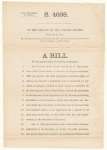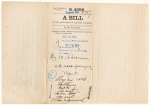Antiquities Act of 1906
2/26/1906
Add to Favorites:
Add all page(s) of this document to activity:

Add only page 1 to activity:
Add only page 2 to activity:
Add only page 3 to activity:
Congress passed the Antiquities Act in 1906 and President Theodore Roosevelt signed it into law on June 8th. The result of a generation-long effort, it was the first law providing general protection for cultural and natural resources in the United States.
The law gives the President the authority, by presidential proclamation, to set aside for protection "...historic landmarks, historic and prehistoric structures, and other objects of historic or scientific interest that are situated upon the lands owned or controlled by the Government of the United States..." Such protected areas are designated "national monuments" and federal agencies that oversee them are required to take care of them.
The first national monument proclaimed under the Antiquities Act was Devils Tower, a geological formation in Wyoming, by President Theodore Roosevelt on September 24, 1906. Roosevelt established 18 national monuments while in office. Today there are over 100 national monuments.
The law gives the President the authority, by presidential proclamation, to set aside for protection "...historic landmarks, historic and prehistoric structures, and other objects of historic or scientific interest that are situated upon the lands owned or controlled by the Government of the United States..." Such protected areas are designated "national monuments" and federal agencies that oversee them are required to take care of them.
The first national monument proclaimed under the Antiquities Act was Devils Tower, a geological formation in Wyoming, by President Theodore Roosevelt on September 24, 1906. Roosevelt established 18 national monuments while in office. Today there are over 100 national monuments.
This primary source comes from the Records of the U.S. Senate.
National Archives Identifier: 28264995
Full Citation: S. 4698, A Bill for the Preservation of American Antiquities; 2/26/1906; Bills and Resolutions Originating in the Senate during the 59th Congress; (SEN59A-B7); Bills and Resolutions Originating in the Senate, 1789 - 2002; Records of the U.S. Senate, Record Group 46; National Archives Building, Washington, DC. [Online Version, https://www.docsteach.org/documents/document/antiquities-act, April 19, 2024]Rights: Public Domain, Free of Known Copyright Restrictions. Learn more on our privacy and legal page.






